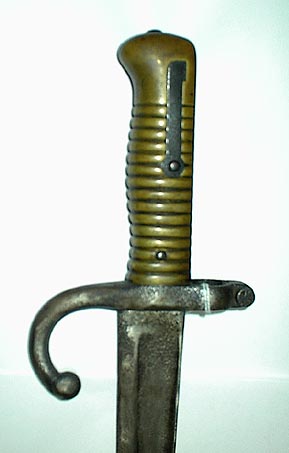Yataghan Sword Bayonet

This is the most widely copied of all the sword bayonets. Many countries - including the United States, Egypt,
Belgium, and Argentina - have manufactured or used very similar bayonets. The French model was designed to fit on
the French Model 1866 Chassepot Rifled Infantry Musket (the musket was revolutionary in itself). It was manufactured
from 1866 to about 1874 and was replaced by the French Model 1874 "Gras" Bayonet.
This bayonet is brass-hilted with a spring steel latching arrangement on the right side. The crossguard is iron
(steel) and has a screw-type tightening arrangement on the muzzle-ring. The lower quillon is a hooked "blade-breaker" type.
The blade is steel, single-edged, fullered (both sides), with a re-curved or "yataghan-shape." The blades are usually marked on
the back-edge (opposite the cutting edge) with the arsenal, month, and year of manufacture; this is done in engraved cursive
fashion and will appear something like, "Mre d' Armes de Chatellerault Janvier 1866" or perhaps "Mre d'
Armes de St. Etienne 8bre [October] 1868". Contrary to novice speculation,
these inscriptions are not the name of a lieutenant or major, nor is it a presentation date.
Additionally, these were not used during the American Civil War.
Arsenals encountered may be such as Chatellerault, Mutzig, St. Etienne, Paris-Oudry, Tulle, and perhaps Steyr (not confirmed on the 1866).
There are numerous variations of this bayonet and they were produced in the many-many thousands.
The scabbards are usually blued sheet-rolled steel with a ball finial.
These bayonets replaced the
French Model 1842 Sword Bayonet and - in turn - were replaced by the
French Model 1874 "Gras" Bayonet
(and corresponding infantry rifle).
These bayonets are very similar to the
Argentine 1879,
Bavarian 1869,
British 1856,
Danish Model 1867,
Turkish 1874, and
various American saber bayonets.
